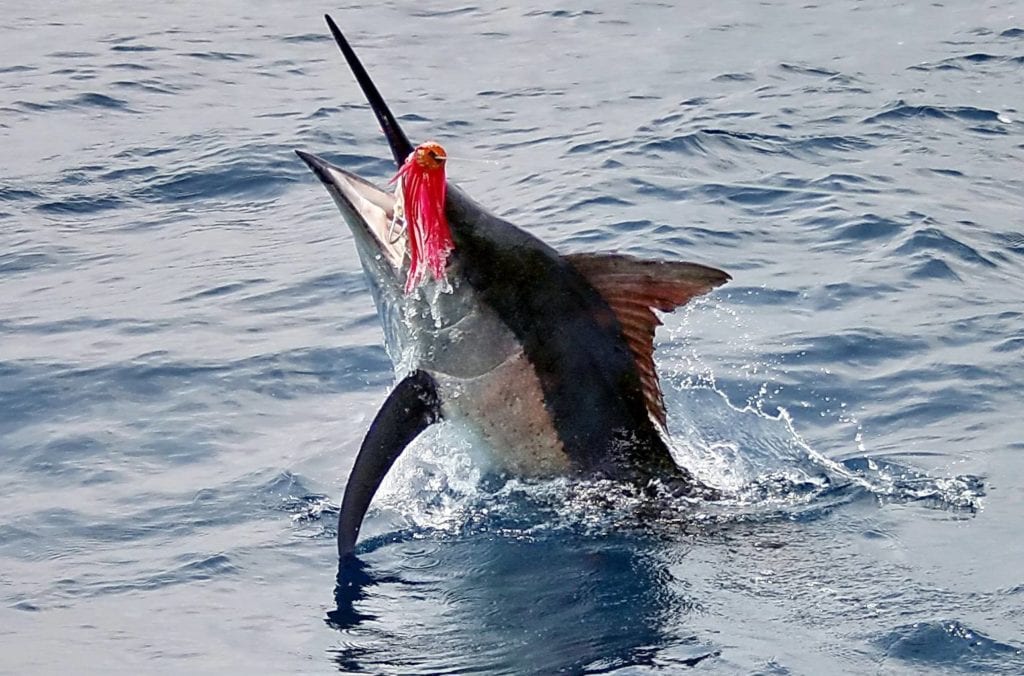Marlin fishing in Panama
Marlin are an apex predator and one of the ocean’s ultimate trophies. Panama Marlin Fishing offers some of the best opportunities in the world. Panama hosts a wide variety of different game fish that often reach their maximum size in the waters.
The Pacific coast of Panama is well known for catching Marlin every month of the year, however our 15 years of experience in the region suggests the best time for Marlin tends to be December through February. During this period we see the largest quantity of Blue Marlin on a daily basis while Panama Marlin Fishing.
Marlin can pop up just about anywhere and have surprised many inshore anglers in pursuit of smaller game. However, good structure that consistently harbors baitfish is a favored habitat. Our favorite spots for Black and Blue Marlin and also Pacific Sailfish is Hannibal Bank and Isla Montuosa located 1.5 hr from our island Lodge. The green season August through September also tend to be excellent for the big female Black Marlin that come to spawn.
Catching a Marlin relies heavily on the skill of the boats skipper, not only in how he handles the boat after the strike but more importantly, the techniques he uses when trolling, his choices of teasers and live bait etc.
Marlin Species found in Panama
Black Marlin – Istiompax indica
Black Marlin are found almost entirely in the Indian and Pacific Oceans but also extends around the African Cape into the Atlantic. The Black Marlin is one of the fastest billfish fish, with speeds of up to 80 mph (130 km/h) . You can tell the difference between a black marlin and a blue marlin by their pectoral fins. The black is the only marlin with rigid pectorals that can’t fold up flat against its body. And the ultimate black to date the all-tackle-record 1,560-pounder came from Cabo Blanco, Peru, in 1953. Black Marlin are present in Panama year around.

Blue Marlin – Makaira nigricans
Hooking and releasing a large blue marlin qualifies for many anglers as sport fishing’s greatest challenge, thrill and accomplishment. Blue marlin are aggressive feeders and a blue marlin bite is something to behold. Seeing the bill of a big blue in a trolling spread and then watching an amazing display of power as hundreds of pounds of angry billfish repeatedly go airborne, make for angling’s most unforgettable sights. The all-tackle record for the Pacific: 1,376 pounds, taken off Kona, Hawaii, in 1982. Over the last couple of years catch-data suggests that blues are becoming a lot more common in our waters in January and February. Their average size is usually around the 300 lb mark but much bigger fish are frequently encountered and landed.

Marlin Fishing Methods
Panama Nautical Club uses a number of different methods when fishing marlin in Panama. Depending on the feeding conditions at the time each method provides results:
- Natural baits rigged to skip and swim, typically we rig Bonita, Skip Jacks or Ballyhoo for trolling marlin
- Artificial lure or skirt to make “skirted baits” or “bait/lure combinations.
Bait is caught on the way to the fishing grounds and stored in our Tuna Tubes on the each boat. The crew will rig the live bait on arrival to the Marlin grounds and slow troll them in hoping gaining a Marlins interest . Artificial lures and deed bait are trolled at a faster speed allowing you to cover a large area. Dolphin are a real nuisance for the crew when we’re hunting marlin. They attack the baits, and the crew needs to manage the bait before the dolphin kills it.
Fighting a Large Marlin
Catching a Marlin relies heavily on the skill of the boats skipper, not only in how he handles the boat after the strike but more importantly, the techniques he uses when trolling, his choices of teasers and live bait. The Captains at Panama Nautical Club are all very experienced and passionate about their fishing so if you are planning a Panama Marlin Fishing holiday and need our advice on the best times to come or any other local information please don’t hesitate to contact us. If you want to talk Panama Marlin Fishing, we can do that all day.

